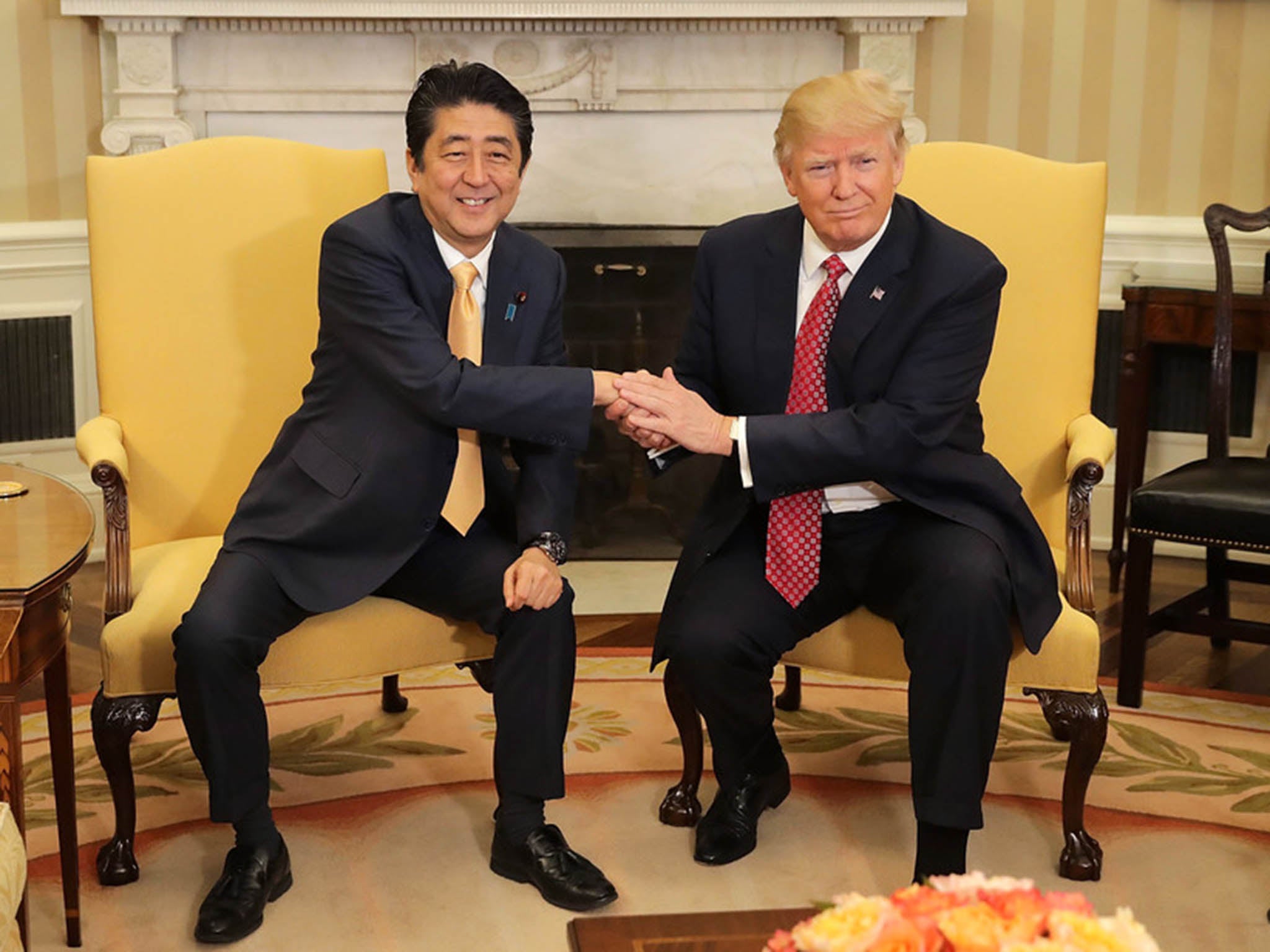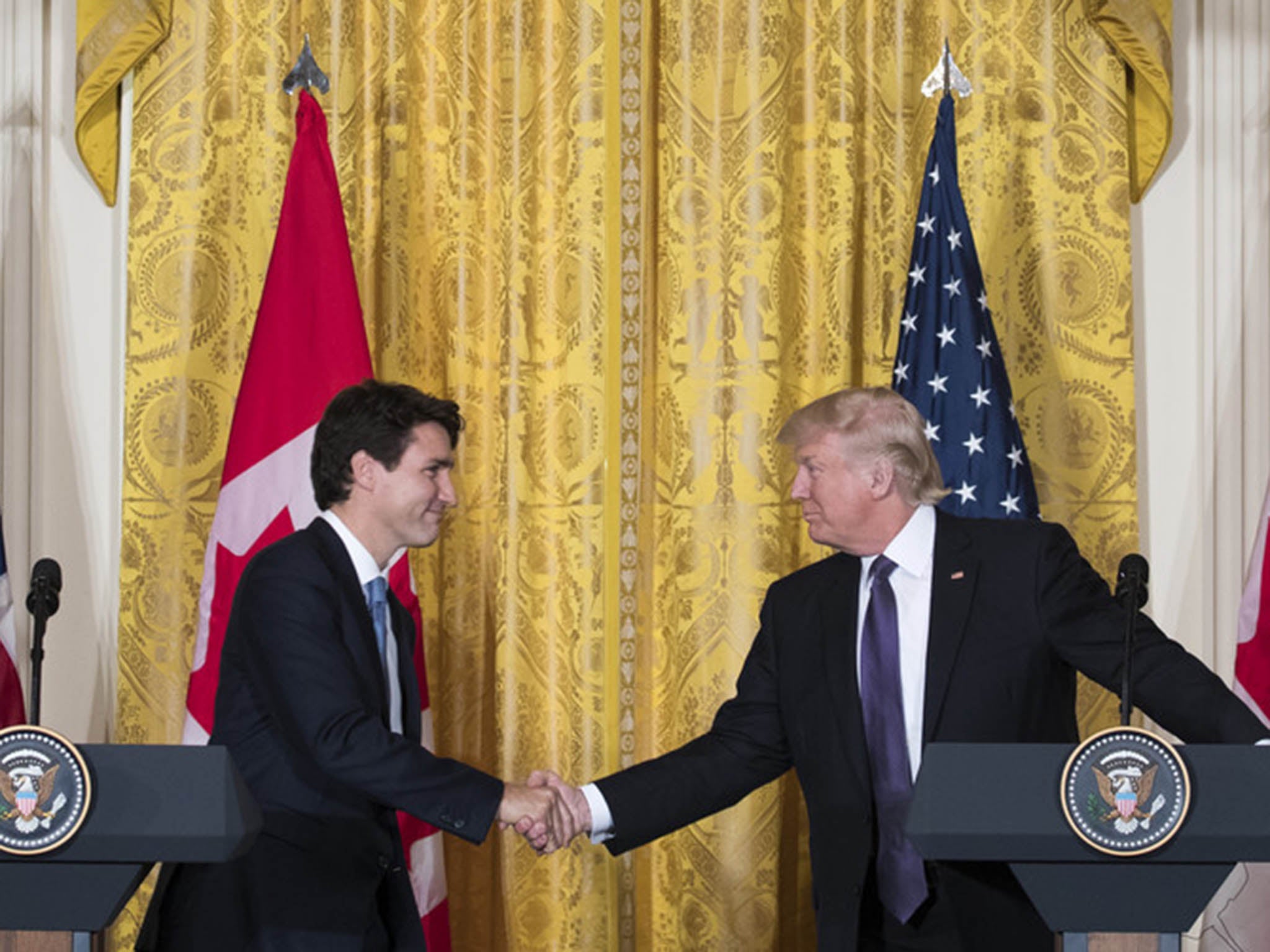The psychology behind Trump's awkward handshake – and how to beat him at his own game
The key is being prepared for battle. Following Justin Trudeau’s example is a good start

Your support helps us to tell the story
From reproductive rights to climate change to Big Tech, The Independent is on the ground when the story is developing. Whether it's investigating the financials of Elon Musk's pro-Trump PAC or producing our latest documentary, 'The A Word', which shines a light on the American women fighting for reproductive rights, we know how important it is to parse out the facts from the messaging.
At such a critical moment in US history, we need reporters on the ground. Your donation allows us to keep sending journalists to speak to both sides of the story.
The Independent is trusted by Americans across the entire political spectrum. And unlike many other quality news outlets, we choose not to lock Americans out of our reporting and analysis with paywalls. We believe quality journalism should be available to everyone, paid for by those who can afford it.
Your support makes all the difference.Handshakes are meant to be relatively simple affairs, at least in terms of their signalling function. “Shake hands on it,” we are told. “Shake and make up.”
They have been used as a civilised greeting for at least 2,500 years. But Donald Trump is now in the process of redefining the handshake, transforming it into the opening salvo in a battle for supremacy.
Handshakes date back at least as far as Ancient Greece – and there are artefacts from that period featuring images of Herakles shaking hands with Athena. Glenys Davies writing in the American Journal of Archaeology said that this particular scene “represents the acceptance of Herakles as an equal by the Gods”.
On other artefacts we find images of Hera, the goddess of women and marriage in Greek mythology, shaking hands with Athena, the goddess of wisdom, craft and war. These handshakes are symmetrical and equal in their execution. The sort of handshake that we would recognise instantly today.
Our common understanding is that the handshake originated as a gesture of peace, demonstrating that the hands are free and not holding a weapon. It is meant to signal cooperation, reflected in the symmetrical nature of the shape of the hands and the movement, not aggressive competition. But tell that to Trump, who uses handshakes as a weapon in his games of one-upmanship.
Indeed, Trump’s handshakes are not acts of peace, solidarity and goodwill, they are something altogether different. His “clasp and yank” handshake has taken many of its recipients by surprise. He pulls them forwards into his personal space, unbalancing them, and putting them at an immediate disadvantage. He knows that images of these greetings will be shown around the world – and that they will make it look as if he is the man in charge.
So potent is his technique that one martial arts school has even come up with advice on how to defend it.
Consider, for example, Trump’s now infamous handshake with Shinzo Abe, the Prime Minister of Japan. Trump first presents his hand to Abe palm up, inviting Abe to take the dominant position with his hand on top. But Trump then clasps his counterpart’s hand for a 19-second marathon handshake, patting the back of Abe’s hand in several bursts of three pats. Hand patting like this is not a “comforting gesture” as some might assume.
Hand patting, like shoulder touching or back patting, is a dominance signal, asymmetric in its application. Our boss can pat us on the back, we cannot pat them in return. Patting is not marked by the sorts of symmetry that constitute a cooperative handshake.
By the end, Trump’s handshake had completely overturned the initial, submissive gesture, and very much made Abe look like the (rather surprised) junior partner. But then Trump is a reality television star – he knows something about the power of iconic images and how moments such as this are perceived by the public.
In a more polite forum, a handshake should be firm, but not too vigorous, and should involve around three shakes of the hand with a full grip. It should be accompanied by a natural smile that fades slowly and an appropriate verbal greeting with the position of the handshake in the mid-zone between the two individuals.
We do know that people make judgements about others on the basis of their handshake. Research conducted by William Chaplin and colleagues from the University of Alabama, for example, showed that the characteristics of a handshake can provide accurate information about aspects of an individual’s personality.
Chaplin reported that handshakes that were “stronger, more vigorous, longer in duration and associated with more eye contact” tended to show that the individual was more extrovert and outgoing, more open to new experiences and less neurotic and shy. Similarly, in my book Get the Edge: How Simple Changes Will Transform Your Life, I discuss how this briefest of ritualised human contacts can reveal aspects of underlying personality.
Those who are particularly concerned about sending out the right signals when they meet people for the first time do think carefully about how to execute their handshake. It is reported, for example, that John F Kennedy thought that handshakes were so important that he commissioned a study to determine the most effective varieties to use when greeting other world leaders.
Some politicians, however, are already giving Trump a run for his money, revealing how the President’s infamous handshake can be disarmed. It certainly looks like Justin Trudeau, the Canadian Prime Minister, prepared himself for handshake war – and we can all learn lessons from how he took Trump on. When they shook hands, Trudeau took hold of Trump’s right shoulder to both steady himself and to stop Trump yanking him forward. And later, when Trudeau shook hands with Trump while they were both seated, Trudeau extended his fingers to signal that he wanted to be released.

Together, these signal that Trudeau had at least some control over the course of the interaction. They certainly play out better than Abe’s attempts and show that Trump doesn’t hold all the cards.
Trump seemingly believes in using any resource at his disposal to gain some advantage in the political and business worlds. Senior politicians expecting routine and formulaic handshakes have been knocked off guard by Trump’s unpredictable behaviour.
They find themselves yanked into his personal space, where it is difficult or impossible for them to make eye contact, or to talk coherently without looking away. This gives Trump an advantage in the game of micro-politics.
His handshakes are clearly all about status rather than solidarity. From a psychological perspective, they are arguably self-serving and egocentric, and demonstrate that, as in many aspects of life, the most important thing to Donald Trump is Donald Trump himself.
The discomfort on Shinzo Abe’s face when his hand was finally released from Trump’s 19-second shake was plain for all to see, but Trump does not seem to care too much for the discomfort of others. If he did, he would not make them ill at ease in such a calculated way.
There’s more to life than handshakes, but they do say an awful lot about the new “leader of the free world”. And if you ever get to meet him, make sure you do your handshake homework first.
Geoff Beattie is a professor of psychology at Edge Hill University. This article first appeared on The Conversation (theconversation.com)
Join our commenting forum
Join thought-provoking conversations, follow other Independent readers and see their replies
Comments